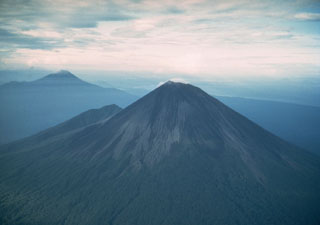Report on Ulawun (Papua New Guinea) — 22 November-28 November 2023
Smithsonian Institution / US Geological Survey
Weekly Volcanic Activity Report, 22 November-28 November 2023
Managing Editor: Sally Sennert.
Please cite this report as:
Global Volcanism Program, 2023. Report on Ulawun (Papua New Guinea) (Sennert, S, ed.). Weekly Volcanic Activity Report, 22 November-28 November 2023. Smithsonian Institution and US Geological Survey.
Ulawun
Papua New Guinea
5.05°S, 151.33°E; summit elev. 2334 m
All times are local (unless otherwise noted)
Rabaul Volcano Observatory (RVO) reported that white steam plumes and occasional puffs of ash rose from Ulawun’s summit crater during 22-24 November, though weather clouds hindered views during 23-24 November. Lava continued to flow from a new fissure vent that had opened on the SW flank, near the vent that had formed in 2019. The intensity of the incandescence from the flow decreased during 23-24 November, suggesting that effusion may have slowed. Seismicity remained at background levels. The Alert Level remained at Stage 2 (on the four-level scale).
Geological Summary. The symmetrical basaltic-to-andesitic Ulawun stratovolcano is the highest volcano of the Bismarck arc, and one of Papua New Guinea's most frequently active. The volcano, also known as the Father, rises above the N coast of the island of New Britain across a low saddle NE of Bamus volcano, the South Son. The upper 1,000 m is unvegetated. A prominent E-W escarpment on the south may be the result of large-scale slumping. Satellitic cones occupy the NW and E flanks. A steep-walled valley cuts the NW side, and a flank lava-flow complex lies to the south of this valley. Historical eruptions date back to the beginning of the 18th century. Twentieth-century eruptions were mildly explosive until 1967, but after 1970 several larger eruptions produced lava flows and basaltic pyroclastic flows, greatly modifying the summit crater.
Source: Rabaul Volcano Observatory (RVO)

